For the first time ever, astronomers have directly observed planets in the process of being born.
Scientists have photographed a gas-giant exoplanet forming around a young star called LkCa 15, which lies about 450 light-years from Earth.

"It's exciting, because it's the first time that we've been able to image forming planets directly," study lead author Stephanie Sallum, a graduate student at the University of Arizona, told Space.com. "It gives us a system to follow up in the future, in depth, to really understand the details of how planets form." [Gallery: The Strangest Alien Planets]
The LkCa 15 system features a large disk of dust and gas surrounding a sunlike star that's just 2 million years old. Such circumstellar disks commonly surround newborn stars, providing the raw materials from which planets form.
Related: Giant Magellan Telescope Breaks Ground in Chile's Atacama Desert
Indeed, previous studies have spotted large gaps in some disks that newly accreting alien worlds likely cleared out. Scientists have even detected disk asymmetries and heat signatures that have been interpreted as evidence of planets inside these gaps.
Such a gap exists in LkCa 15's disk, and one giant protoplanet candidate, known as LkCa 15b, was detected in the system in 2012, at a distance of about 16 astronomical units (AU) from the star. (One AU is the distance from Earth to the sun, about 93 million miles or 150 million kilometers.)

To learn more, Sallum and her colleagues zeroed in on the LkCA 15 system using the Large Binocular Telescope (LBT), an observatory in southeastern Arizona that boasts two 27-foot-wide (8.4 meters) primary mirrors.
Related: Venus' Twin? New Earth-Sized Exoplanet GJ 1132b Found in Our Neighborhood
The team confirmed the existence of LkCA 15b, imaging it directly in hydrogen-alpha photons, a type of light that's emitted when superheated material accretes onto a newly forming world. (Like newborn stars, newborn planets are surrounded by disks of feeder material.)
Other LBT observations revealed the presence of another newborn planet, LkCA 15c, inside the gap and suggested that a third (LkCA 15d) exists there as well, study team members report online today (Nov. 18) in the journal Nature.
"We're seeing sources in the clearing," Sallum said. "This is the first time that we've been able to connect a forming planet to a gap in a protoplanetary disk."
This is a condensed version of a report from Space.com. Read the full report. Follow Mike Wall on Twitter @michaeldwall and Google+. Follow us @Spacedotcom, Facebook or Google+.
More from Space.com:
- Star's Protoplanetary Disc Visualized By Artists | Video
- Alien Planet Quiz: Are You an Exoplanet Expert?
- 10 Exoplanets That Could Host Alien Life
Copyright 2015 SPACE.com, a Purch company. All rights reserved. This material may not be published, broadcast, rewritten or redistributed.